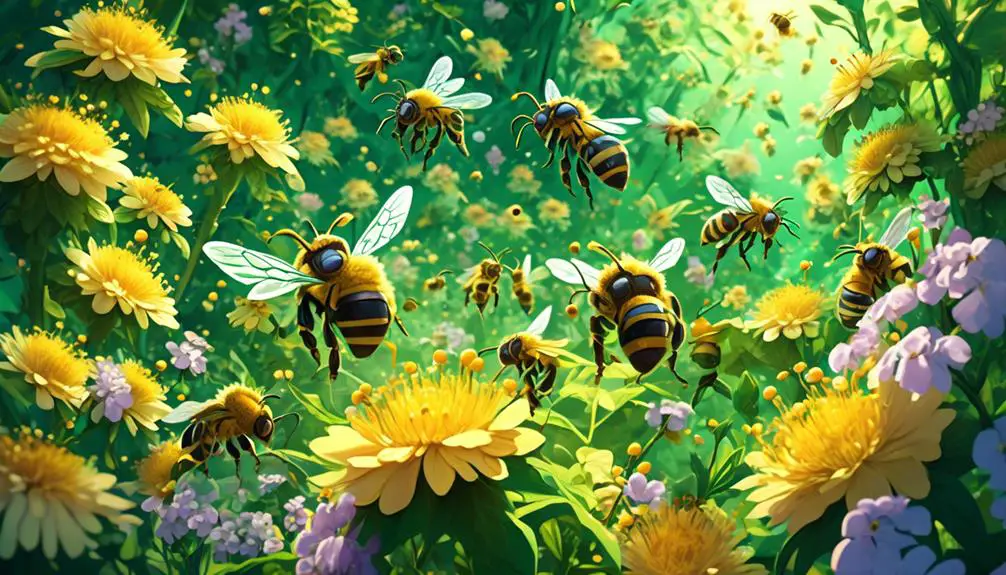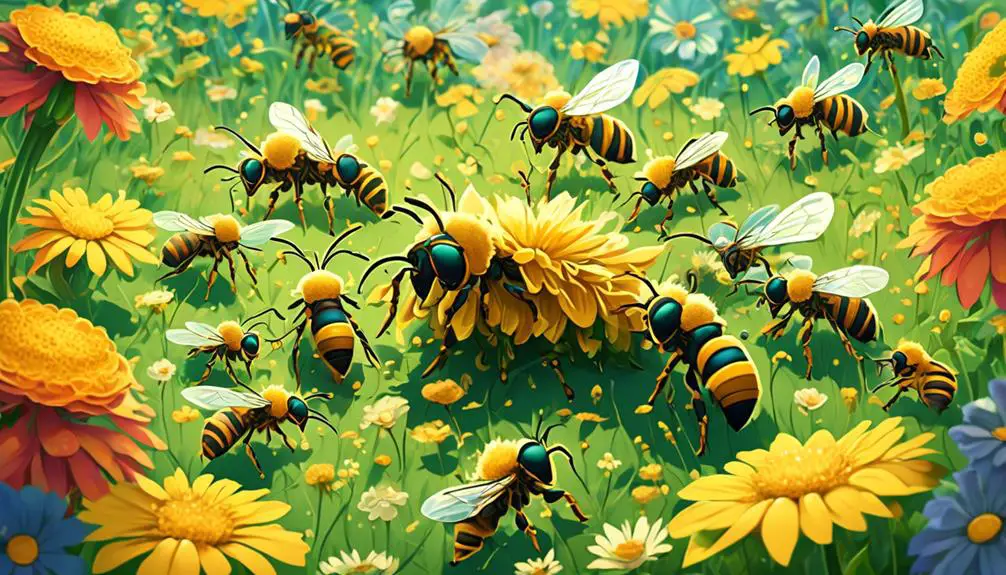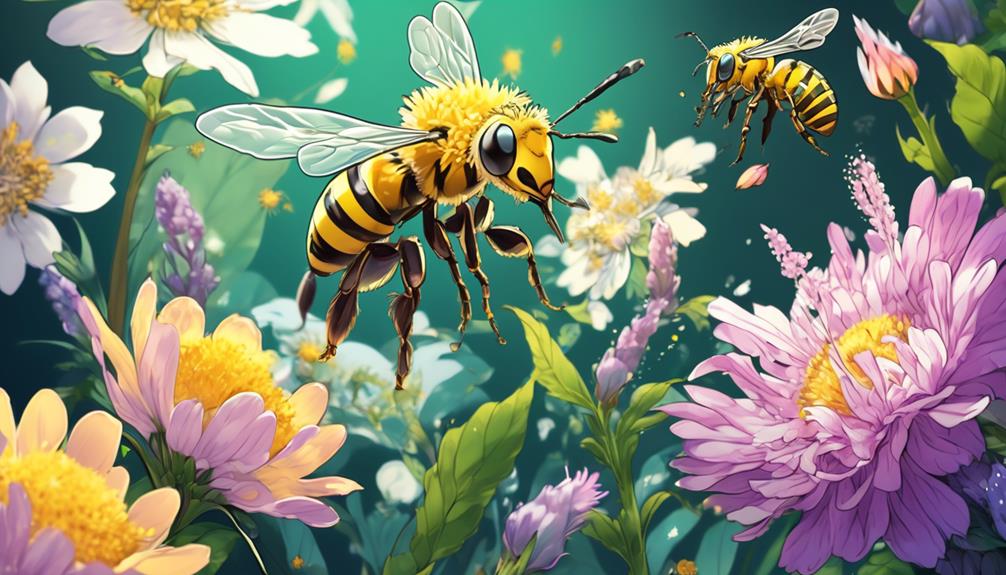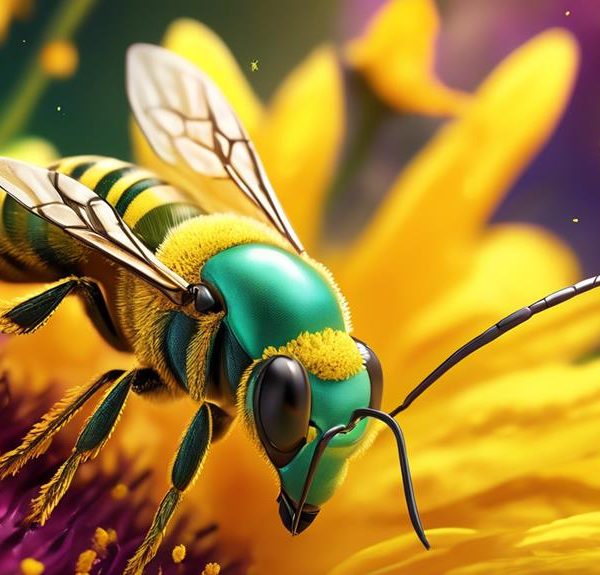Uncover the fascinating social structures of sweat bees and question the existence of a queen in their intriguing hive hierarchy.

Do Sweat Bees Have a Queen
Just like trying to unravel a skein of tangled yarn, understanding the complex social structures of sweat bees can be a perplexing task. You may be familiar with the conventional bee societies where a queen rules supreme, but do sweat bees follow the same monarchy?
This question has been buzzing in the minds of many entomologists. As you embark on this exploration, you'll encounter some intriguing aspects of these tiny creatures and their societal systems.
So, are you ready to lift the veil on this mystery?
Key Takeaways
- Sweat bees have a social structure similar to ants or honeybees, with a queen at the top responsible for laying all the eggs.
- Sweat bee colonies do have a queen bee, but she may not always appear as regal as honey bee queens.
- Sweat bee queens fight for their position and have the main responsibility of laying eggs, as well as foraging for food and taking care of the hive.
- Sweat bees are important pollinators that play a crucial role in increasing biodiversity and ensuring the reproduction and production of food by pollinating a wide variety of plants.
Understanding Sweat Bee Societies

Let's dive into the complex societies of sweat bees, where each insect plays a critical role. You'll find their social structure fascinating, mirroring the well-organized hierarchies of ants or honeybees.
At the top sits the queen, the mother of all bees in the colony. Unlike her counterparts in other bee societies, the sweat bee queen doesn't rule with an iron fist. Instead, she's a symbol of fertility, responsible for laying all the eggs in the colony.
As you delve deeper, you'll see the female workers, the backbone of the society. They forage for food, care for the queen's brood, and defend the nest.
Interestingly, not all sweat bees live in these complex societies. There are solitary sweat bees too, where each female is a queen in her own right, building her nest and raising her offspring alone.
Sweat Bee Reproductive Habits

Diving into the world of sweat bee reproduction, you'll find it as intriguing as their social structure. Sweat bees, unlike honey bees, don't have a typical queen-worker dynamic. In fact, their reproduction strategy is unique among bees.
- Solitary or Communal: Most sweat bees are solitary, with each female constructing and provisioning her own nest. However, some species are communal, where several females share a nest but each still takes care of her own offspring.
- Cleptoparasitic Species: Some sweat bees, such as those from the genus Sphecodes, are cleptoparasitic. They lay their eggs in the nests of other bees, leaving the host to raise their offspring.
- Males and Females: Sweat bee females mate with males and store the sperm for egg fertilization. Interestingly, they can control the sex of their offspring. If an egg is fertilized, it becomes a female; if not, it becomes a male.
Roles in a Sweat Bee Colony

In a sweat bee colony, each member has a specific role to play, creating a well-organized and efficient insect society. These roles are typically based on their age and gender.
The queen, also known as the dominant female, is at the top of the hierarchy. Her main job is to lay eggs and ensure the survival of the colony. Basically, she's the mother of them all.
Workers, who are usually the queen's offspring, perform labor-intensive tasks like collecting nectar and pollen, building and maintaining the nest, and caring for the young. They're the backbone of the colony, ensuring its day-to-day operations.
Male sweat bees, also known as drones, have only one role: to mate with the queen. Once they've done that, their job is considered complete. They don't participate in other colony activities like the workers do.
When the queen dies, a new queen takes her place, ensuring the continuation of the colony. This could be a mature female worker or a newly hatched female.
In essence, each sweat bee contributes to the colony's survival and growth. It's a tight-knit community where everyone has a part to play.
The Sweat Bee Queen: Fact or Myth?

While it's clear that each sweat bee plays a crucial role in the hive, you might wonder if the notion of a sweat bee queen is fact or just a myth. Well, allow me to put your curiosity to rest. Indeed, sweat bee colonies do have a queen bee, much like their honey bee counterparts. However, the sweat bee queen isn't always as regal as you may picture.
Let's delve into some specific facts about the sweat bee queen:
- Position: Unlike honey bees, sweat bee queens don't inherit their position but instead, they fight for it. Only the strong and determined bees become queens.
- Duties: The sweat bee queen's main responsibility is to lay eggs. However, unlike honey bee queens who only lay eggs, sweat bee queens also forage for their own food and take care of the hive.
- Appearance: Sweat bee queens don't have a distinct appearance. They're similar to worker sweat bees, making them hard to identify.
Impact of Sweat Bees on Pollination

Despite their small size, sweat bees pack a powerful punch when it comes to pollination, playing a key role in maintaining the balance in our ecosystem. You mightn't notice them as much as honey bees or bumble bees, but they're just as vital.
Sweat bees are solitary creatures, but they're industrious pollinators. You'll often find them in your garden, busily hopping from one flower to another. They're not picky, either. Sweat bees will pollinate a wide variety of plants, helping to increase the biodiversity in your area.
You might be wondering, 'What's the big deal about pollination?' It's more important than you might think. Pollination allows plants to reproduce and produce the fruits, vegetables, and nuts that you enjoy. Without pollinators, like sweat bees, our food system would be in serious trouble.
Conclusion
So, do sweat bees have a queen?
Yes, they do. Each colony has one queen who lays all the eggs. The rest of the bees, mainly females, work tirelessly to support their queen and colony.
Despite their tiny size, sweat bees play a big role in pollination, helping our plants to thrive. Next time you spot these little workers, give them a nod of respect for their contribution to our ecosystem.


